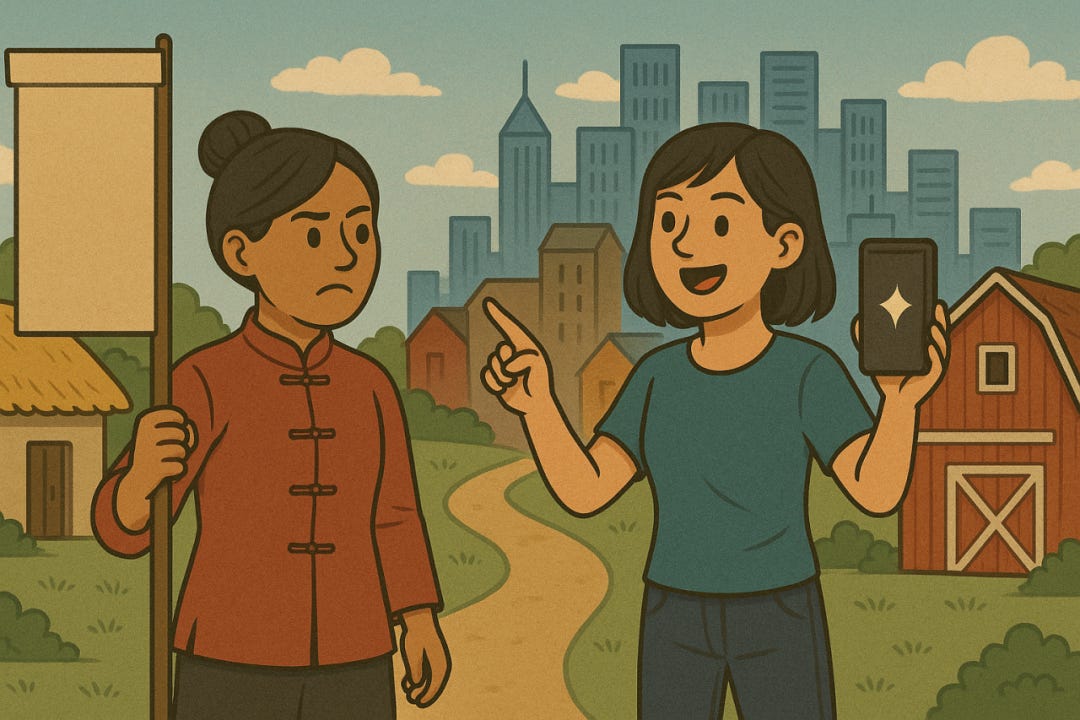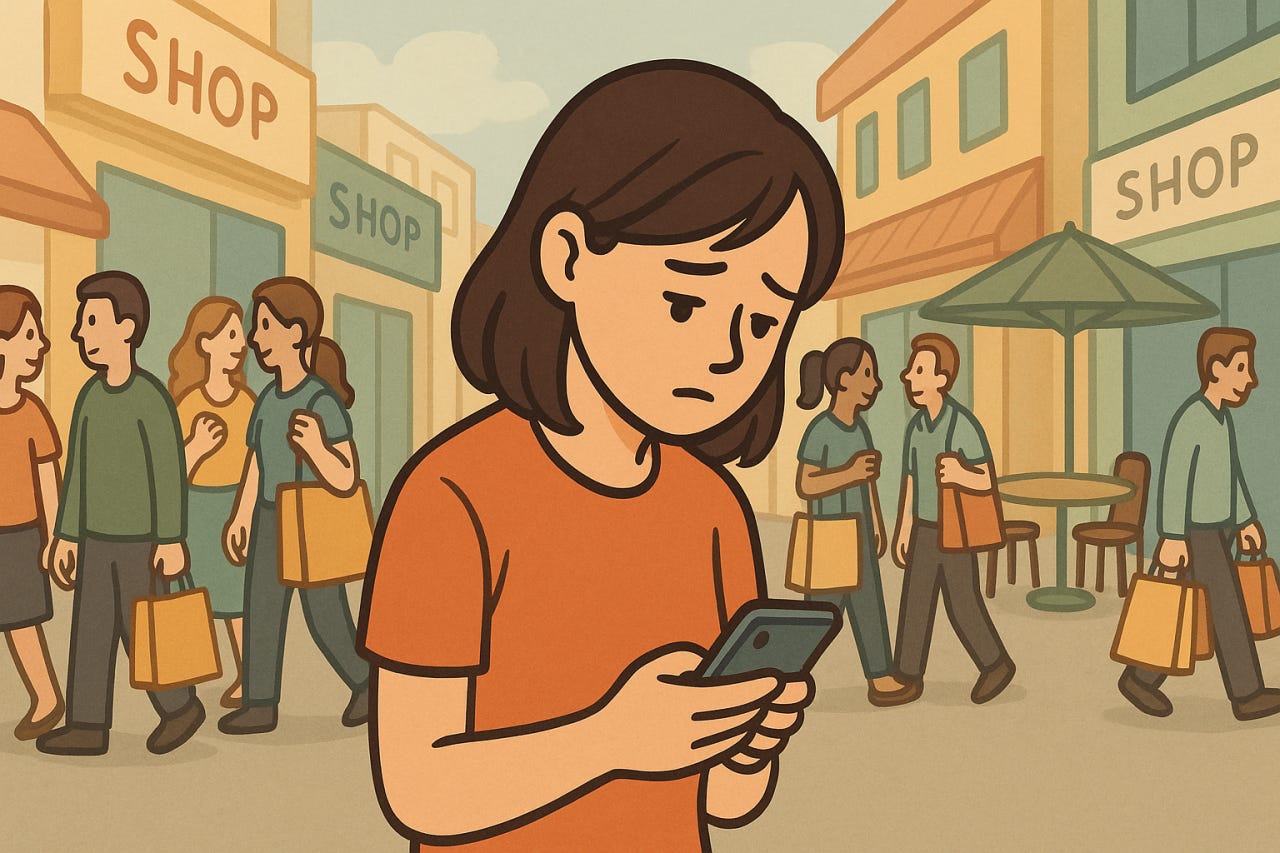Where happiness comes from for China's rural migrant women?
Study finds local connections, rather than material aid, drive happiness of this resilient group
Today's piece features a study which offers a valuable lens on rural migrant women's sources of happiness amid China's sweeping urbanization. A few findings stood out:
Many interviewees said that while their lives are far from comfortable, they are not yet at the point of needing material aid. By the time they truly need money or goods, the psychological burden is already heavy. Accepting material help can also leave them feeling indebted. They prefer to solve problems through their own efforts and long more for understanding and support than for handouts.
Institutional help is scarce, largely because of limited awareness of—and trust in—government and social-sector services. Only 0.2% of respondents reported receiving such support. Most still rely on parents and partners, yet mobility has separated them from day-to-day family care. In this gap, neighbors have become the most practical point of entry to social support.
Together, the study sketch a resilient portrait of rural migrant women striving in unfamiliar cities, for their families and for themselves, learning to adapt and press on. Their happiness is not only about "being cared for," but increasingly about "having agency."
I am grateful to Gu Moli顾茉莉 (PhD candidate, College of Geography, Nanjing Normal University), Professor Tang Shuangshuang汤爽爽 (College of Geography, Nanjing Normal University), and Associate Professor Feng Jianxi冯建喜 (School of Architecture and Urban Planning, Nanjing University) for this work, and I salute their contribution.
Parts of the study was published in May on the WeChat account Demogossip 严肃的人口学八卦. Below is my own translation.
中国农村流动女性的幸福感来源于哪里?社会支持与邻里环境的作用
Where Does the Happiness of China's Rural Migrant Women Come From? The Role of Social Support & Neighborhood Environment
Mobility is not only a shift in physical space. It also reorganizes emotional structures and systems of meaning.
In traditional thinking, rural Chinese women's happiness is closely tied to the family—having a caring husband and successful children is treated as their primary "report card." At the same time, they have seldom held the power to decide whether to move, rarely leaving familiar hometowns and relatives, and have found it hard to take charge of their own lives.
Today, more rural women are becoming "mobile." Through education, they accumulate personal capital and gain greater autonomy amid social change. They leave their villages for cities, searching for new possibilities in personal growth and career development. Their sources of happiness also expand from the family to a wider life sphere.
Against this backdrop, has the city become their new "home for happiness"? Can new social ties and living environments offer emotional support and a sense of belonging? To explore these questions, we conducted a study in Nanjing, capital of east China's Jiangsu Province, using questionnaires and interviews.
What do they face when they move to the city?
Because of long-standing gendered power inequalities, rural women have typically played subordinate, caregiving roles in the family and possess relatively weak personal capital. Entering modern public spaces does not immediately change this situation; instead, it often layers on new challenges. They need to navigate structural barriers such as scarce social resources and status restrictions, while also confronting sharp tensions between old and new cultural values.
In terms of social relations, the kinship- and locality-based networks they once relied upon are weakened by spatial separation and altered interaction patterns. In cities, new social ties are hard to build because of the household registration system (hukou) and resource barriers. Psychologically and in daily life, they occupy a liminal state of "needing support but struggling to obtain it." At the initial stage in cities, they mainly depend on "strong ties" with family members and fellow villagers. Although this mode of interaction can provide short-term comfort and encouragement, it rarely delivers truly diverse resources or deep emotional integration and, over time, constrains their happiness prospects.
To cope with real-world pressures and a dual dilemma of emotional and informational needs, they must rebuild social networks in urban settings to access support. In this process, the neighborhood, an important social arena, becomes a key platform for forging new connections and expanding support. Yet the pace of urban life and institutional designs continually thin out the warmth of interpersonal bonds. Focused on making a living, they tend to pay little attention to the neighborhood environment, and the spatial layout of urban communities further reduces opportunities for neighborly interaction. In such a context, can new social support and neighborhood settings still enhance their well-being?
Does social support really increase happiness?
Our findings show that emotional support, informational support, and social companionship are the core factors that enhance the happiness of rural migrant women. Put simply, emotional support soothes the heart and eases loneliness; informational support helps them solve practical problems at work and in daily life; social companionship makes them feel "not alone."
We also find that purely material, instrumental assistance can have negative effects. This is because, within Chinese cultural values and gender norms, women place greater emphasis on emotional exchange and companionship. Emotional support and companionship meet rural migrant women's affective needs in unfamiliar cities, reduce loneliness, and strengthen social identification, thereby boosting subjective well-being. By contrast, accepting material help often requires acknowledging one's difficulties, which itself creates psychological pressure.
Many interviewees noted that although their living conditions were modest, they had not reached the point of needing material aid; and when they truly needed money or goods, significant stress was already present. Moreover, receiving material assistance can produce a sense of indebtedness, a burden in its own right. They prefer to solve problems through their own efforts and especially want to be "understood" and "supported," rather than to be the passive recipients of "charity."
Equally noteworthy is that limited awareness of and trust in services from government and social organizations leaves institutional support scarce. Only 0.2% of respondents reported receiving support from these channels. Most still rely on parents and partners. Yet the spatial separation brought by mobility makes it hard to obtain close, day-to-day help from relatives, which in turn makes the neighborhood the most realistic entry point for social support.
What role does the neighborhood play?
Ideally, the neighborhood should be the most accessible layer of support in urban life for rural migrant women. In reality, however, support originating from neighbors accounts for only about 1%. Interviews indicate that neighborly exchanges mostly stop at nods and greetings, with few acts of substantive support. Does the neighborhood still shape their well-being? We analyze this from two angles: the "built environment" and the "social environment."
In the built environment, high-density housing, busy traffic, and abundant facilities improve convenience and travel efficiency but hinder the formation of support systems, reducing subjective well-being. On one hand, high density, fast pace, and high housing costs speed up residential turnover, obstruct the building of stable relationship networks, increase life pressures and isolation, and create a paradox of "the more convenient, the lonelier."
On the other hand, when renting, they prioritize price and commuting distance and rarely attend to community qualities. In fact, the neighborhood environment subtly shapes happiness. Constrained by patriarchal norms and long working hours, their social interaction and leisure are limited; they prefer low-cost, convenient ways of socializing. An abundance of leisure spaces can sometimes imply higher social costs, adding pressure instead of relief. The result is that seemingly rich urban resources may intensify feelings of separation and loneliness.
In the social environment, good neighborly interactions or a cohesive circle of friends significantly boost happiness. Such ties provide emotional belonging and functional help with information and material needs, while also reinforcing both group and self-identity in the process of interaction. However, as the number of friends grows, information overload and uneven quality can generate new stress. Because of high mobility and weak social capital, these women's community networks in cities are often loose and heterogeneous; even "a quantity of ties" is hard to convert into "quality support."
Thus, even when their neighborly relations are not close and their attention to the environment is limited, these factors still, invisibly, shape access to support and experiences of happiness. For them, the neighborhood is a "double-edged sword": it can offer warmth, or become ineffective because of unfamiliarity and distance.
Conclusion
Rural migrant women are remarkably resilient. In unfamiliar cities, they strive for their families and for themselves, adapting and persevering. Their happiness is no longer just about "being cared for," but also about "having autonomy." Being heard, understood, and respected — these subtle yet real social bonds — bring more comfort than money or material aid.
Their happiness also extends beyond the family to new social ties and neighborhood settings. The neighborhood is not merely a backdrop to life; it is a touchpoint in the social support network and an emotional field where they can "settle down" and "feel at ease." Although institutional support is currently thin and neighborly ties can be distant, this does not make them unimportant. An inclusive space for interaction or a sincere conversation could be the moment when they "find themselves again."
Amid ongoing urbanization, urban planning and governance often overlook the social needs and happiness of mobile populations, especially rural migrant women. Constrained by gender roles and structural barriers, they are more prone to social isolation and to difficulties in building stable support networks. The key to improving their subjective well-being is not simply to "give" support, but to reshape a social space in which they are "seen," "understood," and "accepted," making support a reachable part of everyday experience.
References
Gu, M., Tang, S., & Feng, J. (2025). Neighborhood environment, social support and subjective well-being of rural migrant women: A case study of Nanjing, China. Habitat International, 160, 103406. https://doi.org/10.1016/j.habitatint.2025.103406
Note: The images in this article are generated by AI.






